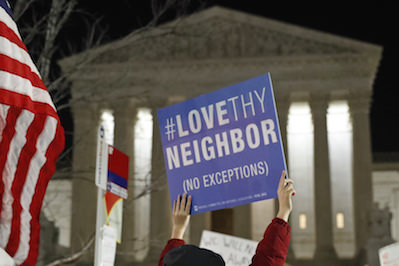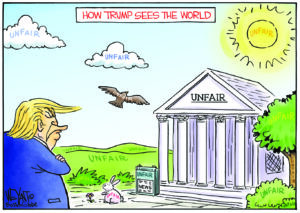Trump’s War on Immigrants Has Already Reached the Supreme Court
A series of cases on the current docket—not the president's “Muslim ban”—has brought the contentious issue of immigration to the nation’s top court.
A protest at the Supreme Court over President Trump’s executive orders. (Alex Brandon / AP)
If you’ve been waiting for President Donald John Trump’s war on immigrants to reach the Supreme Court, your wait is over. The battle has already begun.
No, the conflict hasn’t come to the top court by way of Trump’s high-profile “Muslim ban,” which has been enjoined by a series of lower court decisions, including one handed down on Feb. 9 by the 9th U.S. Circuit Court of Appeals. The administration has backed away from its threat to seek immediate Supreme Court review of those unfavorable rulings in favor of revising the ban on narrower terms.
But even before the original travel ban was announced on Jan. 27, the Supreme Court had loaded up its current docket with cases that will have profound consequences for Trump’s war, especially his plans to secure and militarize the border and fulfill his campaign promises of mass deportations.
Two appeals before the Supreme Court stand out in particular. Although both originated well prior to November’s election, the federal government is represented in them now by Jeff Sessions’ Justice Department.
The first is Hernandez v. Mesa, which was argued last week.
The facts of the case are gut-wrenching: As dusk fell on the evening of June 7, 2010, a group of Mexican teenagers was playing a game in the sprawling concrete culvert that winds between the cities of Juarez, Mexico, and El Paso, Texas. The actual boundary between the two countries is unmarked but is plotted along the middle of the culvert. Security fences sit atop the culvert on both sides of the divide.
The game, according to subsequently filed court documents, involved the teens daring one another to run up the culvert’s northern incline to the American side, touch the U.S. fence and scamper back down to Mexican territory.
For one of the participants—15-year-old Sergio Hernandez—the game proved deadly. He and his buddies were confronted by U.S. Border Patrol Agent Jesus Mesa, Jr., who was on the lookout for alien smugglers attempting to bring people into the States.
With his handgun drawn, Mesa apprehended one youth by the shirt collar on the American side of the border, then turned in the direction of the others who had run away. He fired his weapon, striking Hernandez in the head from a distance of approximately 60 feet. Hernandez died instantly beside a concrete pillar on the Mexican flank of the culvert.
In the aftermath of the shooting, Mesa claimed that he had been surrounded by Hernandez and the other teens, and that they were throwing rocks at him. Those claims were later disproved by a cellphone video taken by an onlooker. The video, which was aired by both American and Mexican TV outlets, showed no rocks being hurled or any other imminent threats to Mesa’s safety.
Mexican authorities charged Mesa with murder, but the U.S. refused to extradite him. In 2012, the FBI cleared him of criminal wrongdoing. The Justice Department also exonerated him in another investigation of the shooting, finding that Hernandez, despite his age, was a known smuggler who had been arrested twice before in the U.S. on smuggling charges but was allowed to return voluntarily to Mexico without prosecution because he was a juvenile.Seeking a judicial remedy, Hernandez’s parents filed a wrongful death action in federal district court in Texas against the Department of Homeland Security, the Border Patrol and other agencies, as well as Mesa. They alleged that their son’s Fourth Amendment rights to be free from unjustified lethal force had been violated, along with his rights to due process under the Fifth Amendment.
A federal district court judge dismissed the suit, holding that Hernandez enjoyed no constitutional protections because he was in Mexico when he was hit, even though Mesa was standing on American soil. Although a three-judge panel of the 5th Circuit Court of Appeals reversed that ruling, an en banc panel of 15 circuit court judges reinstated the dismissal in April 2015, setting the stage for a showdown in the Supreme Court.
The Hernandez case is important not only in its own right, but because border-area shootings involving U.S.agents have proliferated at an alarming rate. According to an amicus (“friend of the court”) brief filed with the Supreme Court by the Mexican government, U.S. Customs and Border Patrol officers have killed 51 people since 2005. Several of the fatalities were caused by shots fired across the border.
Still, Hernandez’s parents face an uphill road in the Supreme Court. Even the court’s four liberals seemed hard-pressed during the oral argument to articulate a rule of law or identify a Supreme Court precedent that could allow the case to proceed to a trial on the merits.
At one point in the proceedings, Justice Stephen Breyer suggested that the court’s 2008 decision in Boumediene v. Bush might provide a way forward. In that case, the court held, by a hotly contested vote of 5-4 in a majority opinion written by Justice Anthony Kennedy, that prisoners incarcerated in Guantanamo Bay, Cuba, could challenge their detentions on Fourth Amendment grounds in U.S. courts, even though they weren’t American citizens and were confined outside the country.
Chief Justice John Roberts, however, sharply disagreed with Breyer over Boumediene’s relevance. If Mexican nationals were accorded constitutional protections against the kind of deadly force used by agent Mesa, Roberts asked, why wouldn’t Iraqi victims of air attacks by drones guided from Nevada have similar protections and be able to file lawsuits in American courts? The clear implication was that such a liberal interpretation would jeopardize U.S. sovereignty.
By any measure, the stakes in the Hernandez case are high. A victory for the parents could give refugees and others denied visas to enter the U.S. new avenues to contest future Trump travel bans. A loss would likely do the opposite. It would also embolden the Border Patrol to continue its Gestapo-like tactics with impunity. Should the court divide 4-4 along party lines, the Fifth Circuit’s adverse decision would remain in force.
The other immigration case with big implications for Trump’s crackdown is Jennings v. Rodriguez, a class action dealing with the rights of immigrants detained pending deportation hearings to receive bail hearings.
On any given day, on average, Immigration and Customs Enforcement (ICE) detains 34,000 people, many in privately owned and operated prison facilities that are poised to prosper and expand during Trump’s tenure. Under the president’s recently promulgated executive orders on immigration and the Department of Homeland Security (DHS) memorandums implementing the orders, the daily count of ICE detainees is projected to mushroom to 80,000 as the administration moves to end the agency’s “catch and release” programs, which allowed unauthorized immigrants to be paroled into the community on bond or their own recognizance, pending deportation hearings. The named plaintiff in the case, Alejandro Rodriguez, represents a class of some 1,000 people who have been subjected to ICE detentions of six months or more. Rodriguez was brought into the country as an infant from Mexico. He gained lawful permanent resident status when he was nine years old, and as an adult he became a dental assistant.
But he also ran into to trouble with the law, sustaining criminal convictions for joyriding at age 19 and misdemeanor drug possession at 24. In 2004, he was taken into ICE custody, placed in mandatory detention because of his criminal history and denied bail.
Rodriguez lost his deportation hearing, but with the ACLU representing him, he filed an appeal with the 9th Circuit. While the appeal was pending, in 2007, ICE finally released him from detention, and an immigration judge eventually canceled his removal from the country. In all, he spent more than three years in ICE detention.
In 2015, the 9th Circuit handed Rodriguez and his fellow plaintiffs a resounding victory, declaring that aliens detained by ICE for six months or more have a statutory right to a bail hearing under various provisions of federal immigration law. The Supreme Court subsequently granted the Obama administration’s petition for review. Since Trump’s election, the case has taken on added significance.
After hearing oral arguments in November, on Dec. 15 the court asked the parties to submit supplemental briefs, addressing the issue of whether long-term ICE detainees have a constitutional—not just a statutory—right to receive bail hearings. The briefs are now on file, and a decision is expected by the close of the court’s present term at the end of June.
While it is difficult to predict how the court ultimately will rule, even a tie vote this time would favor immigrants’ rights, allowing the 9th Circuit decision to stand and dealing a dramatic blow to Trump’s anti-immigrant agenda.
Whatever the outcome in Rodriguez’s case, however, Trump’s war on immigrants has landed in the marble halls of the nation’s most powerful judicial body and is only just beginning. As the great French commentator Alexis de Tocqueville wrote in his seminal text “Democracy in America” in 1835, “There is hardly a political question in the United States which does not sooner or later turn into a judicial one.”
We’ll see in due course whether the Supreme Court is prepared to enforce the principles of judicial review and stand up to Trump—or turn the third branch of government into a legal rubber stamp.
Independent journalism is under threat and overshadowed by heavily funded mainstream media.
You can help level the playing field. Become a member.
Your tax-deductible contribution keeps us digging beneath the headlines to give you thought-provoking, investigative reporting and analysis that unearths what's really happening- without compromise.
Give today to support our courageous, independent journalists.






You need to be a supporter to comment.
There are currently no responses to this article.
Be the first to respond.